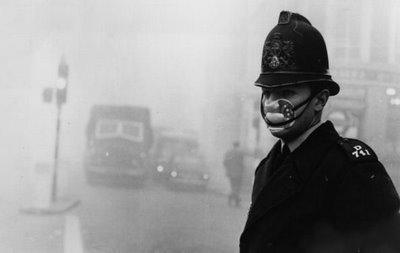In a somewhat rare weather phenomenon, an anticyclone formed over London during the bitter cold of the late 1952 winter. Something like an inverted hurricane, the anticyclone is a clockwise (counter-clockwise in the southern hemisphere) rotation of winds around a high pressure region above a cold pocket. Inside, air becomes even colder and typically drier with clear skies, though it can also produce heavy fog as surface relative humidity increases. The lack of internal wind compounds gasses that would typically escape, which became the key to creating a nightmarish weather condition that plagued London for five days.
As the anticyclone settled over London, most citizens thought little more of the colder weather than an annoyance. They heaped more coal onto their furnaces and turned on lights, which meant more electricity from the coal-power plants around London. As the fires continued, the windless low pressure system did not let the smoke escape, and pollutants like carbon soot, nitrogen oxides, and sulfur dioxide began to thicken the growing fog. By December 5, visibility was reduced to a few yards.
Even though it was a thick, smoky fog, Londoners did not raise concern quickly. The old days of “pea soupers” (fogs as metaphorically as thick as pea soup, sometimes even green-tinted fog from industrial pollutants in the nineteenth century) were not far in the past, and London had always been known for its fog. Children were released from school as “parents were advised not to risk letting their children get lost on the way to school,” according to Prime Minister Ken Livingstone, who experienced the Great Smog as a boy. Above-ground traffic came to a standstill, ending all public transport outside of the Underground. Even ambulance services were halted, forcing the ill to get to hospital on their own.
Somewhere amid the haze, a rumor started that the smog was poisonous. It was in fact poisonous, due to its composition of pollutants, but most had fair air quality within their homes and wore handkerchiefs over their mouths and noses when they went out. Young children and people with respiratory problems were the few to face real danger. However, as people saw more and more deaths (estimates calculate that 4,000 more people died than usual), panic began to strike. People attempted to flee their homes, overloading the Underground until it too broke down and was unfixable in the dense fog.
As December 6 and 7 rolled on, the fog became denser. In some places, visibility decreased to less than a foot, making walkers outside unable to see their feet or even their hands with arms outstretched. Smoky fog seeped into buildings where it could, and the panic turned to all-out chaos. Rioters smashed into shops initially looting survival gear and then, after it became obvious police were unable to respond, anything of value. Fires broke out, adding to the smog and sense of Armageddon. As reporters and what newspapers were able to continue to print spread word of the madness, riots spread further.
Prime Minister Winston Churchill called in aid from the armed forces who were able to communicate by radio but unable to react to one another outside of a few yards. They attempted to canvas the city, but resources were stretched too thin to alleviate much of the rioting and damage. Primarily, the soldiers assisted in evacuating the city, a sight not seen since the days of the Blitz, escorting civilians onto special slow-moving trains bound for the North and Southwest.
Finally on December 9, the anticyclone dissipated, and the fog lifted from the scarred remains. An estimated 8,000 more people died due to respiratory complications, and commerce in the city was limited for weeks during cleanup. The government launched into numerous studies on the problems of low-grade coal fires and began legislation promoting paraffin heaters and then electric. Further actions led to the Clean Air Act of 1956, much improving restrictions on pollutants. Meanwhile, other studies questioned the impact of media on spreading the panic. The Conservative government put into effect new regulations managing the emotional coverage of news in times of emergency, reestablishing review boards similar to those during the counterespionage days of WWII.
Although rarely taken into play, numerous fines were handed out for reports on the battles between Mods and Rockers during Whitsun weekend in 1964, giving ironic government support to the youth subcultures as media portrayed them as folk devils.
--
In reality, there was not much concern over the Great Smog. It was not until after the fog cleared that doctors and coroners began to notice the increased death numbers. Environmentalism came to the forefront of the political discussion, and numerous Clean Air Acts have since been passed.

Very interesting article, this could have easily become reality. Nice picture.
ReplyDelete